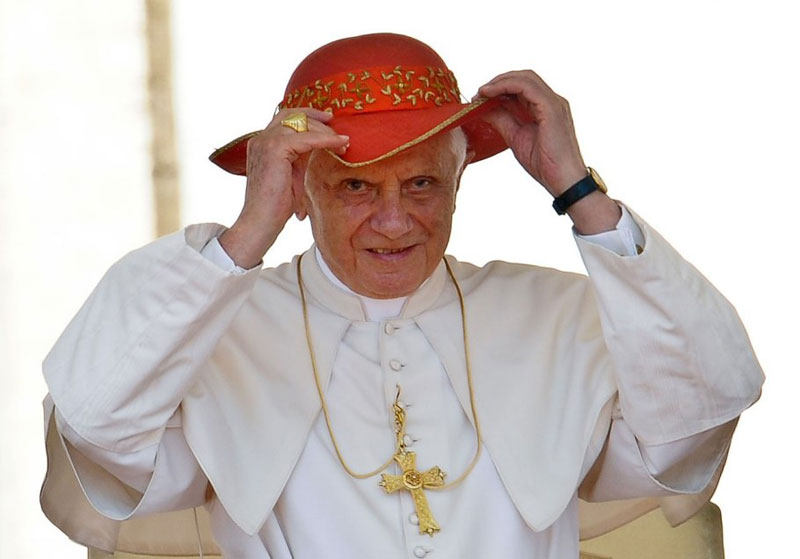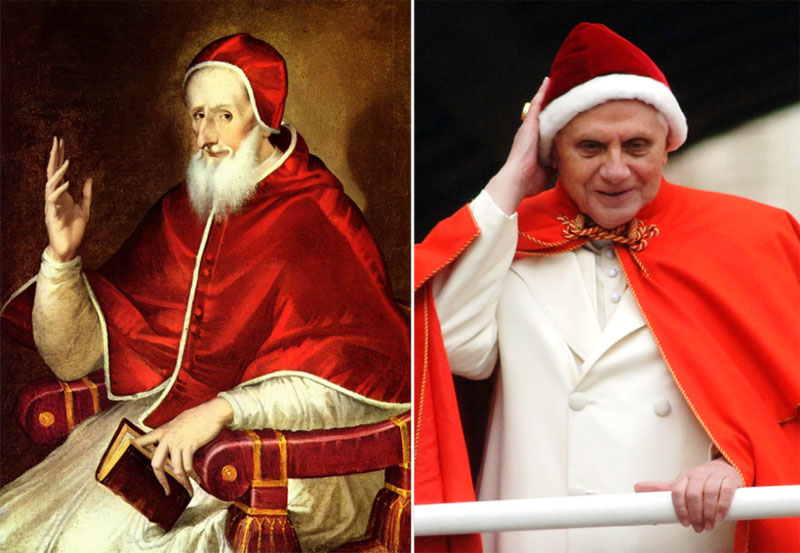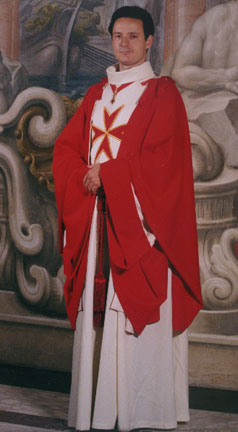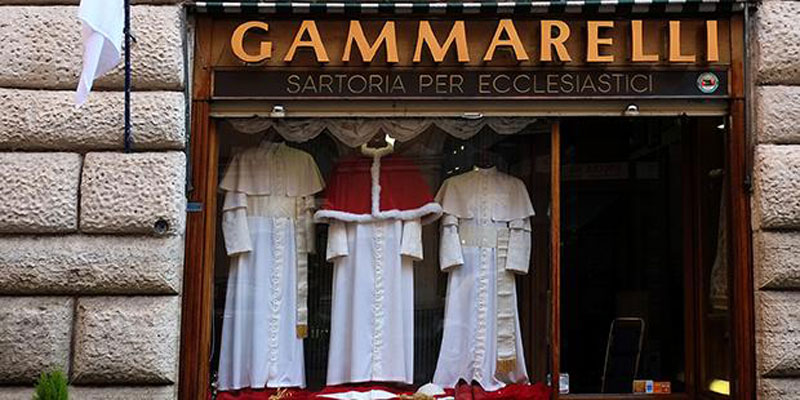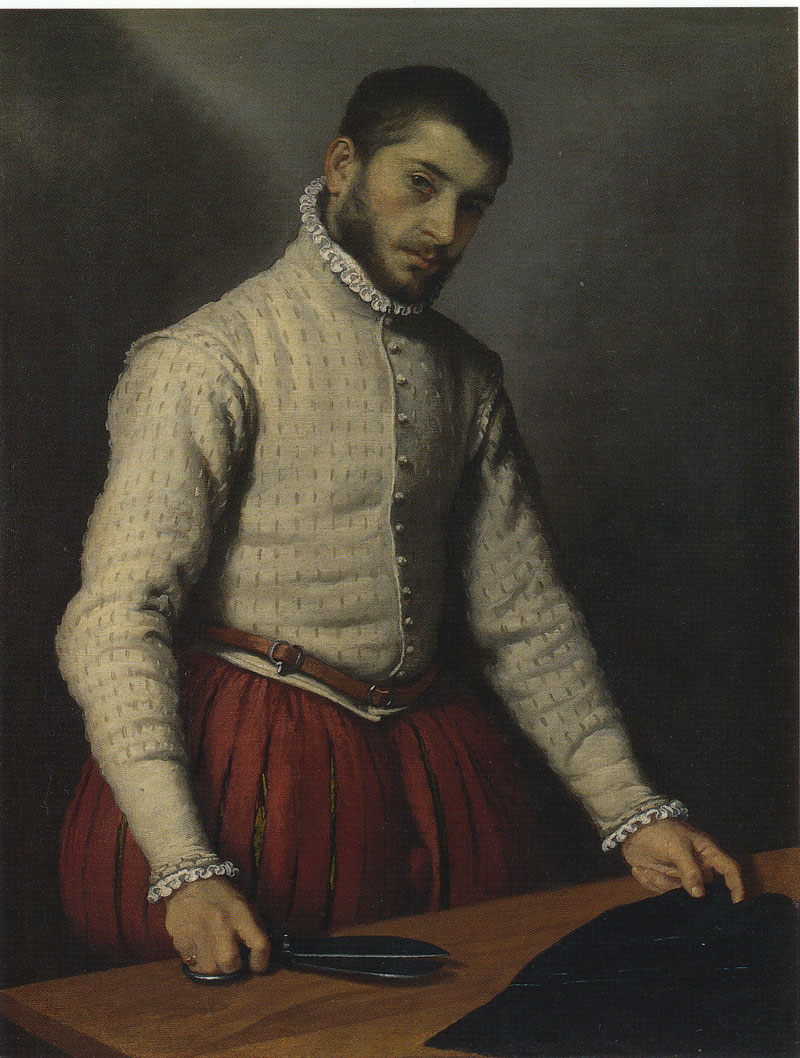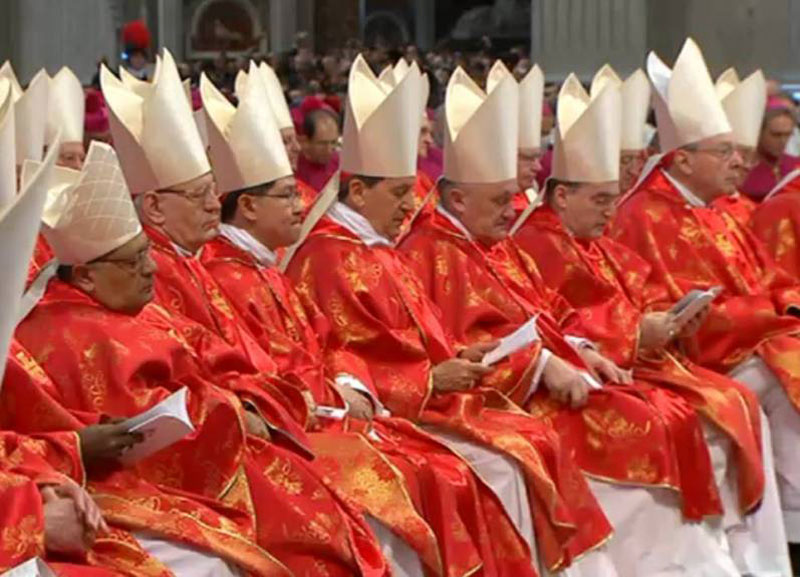When Pope Benedict XVI announced the election of 22 new cardinals in February, 22 people all over the world immediately reached for the telephone to call their ecclesiastical outfitters of choice in Rome and order their new wardrobe – scarlet biretta, scarlet cassock and scarlet socks.
In fact there are only a handful of shops that specialize in ecclesiastical garb (both liturgical and non-liturgical) for the sacerdotal elite of the Church. Most of these are clustered together in the centre of Rome, behind the Pantheon, just off the aptly named Piazza delle Stimmate (Stigmata Square). The world of ecclesiastical clothing, like the Vatican itself, is a strange, hermetic, esoteric one, veiled in discretion and mystery. One knows when one is approaching this venerable quartier, as the density of clerics, already great in Rome, suddenly increases – everywhere you look are clerics of all echelons and sizes – bishops from Benin to Brazil and cardinals from Columbia to Korea.
Ghezzi, on the via de’ Cestari, one of these ecclesiastical outfitters, looks like an old-fashioned department store in a provincial town, with no attempt at modern window dressing – old mannequins and windows stuffed with religious appurtenances. As well as clerical clothing, they sell everything from tabernacles to thuribles and sconces to monstrances. When I visited recently, I was given a reception no less frosty than the weather by the pasty-faced female manager. Perhaps I was not dressed reverentially enough – I was wearing a baseball cap, as it had been a day of torrential rain and hailstones. I explained in my politest Italian that I wished to buy a bishop’s biretta and asked her about the different purple birettas on the stand. She was reluctant to answer any of my questions and, when she saw me looking at price tags on various chasubles and making notes, she asked me to leave and threatened to call the police! I left, but wondered what felony or misdeed I could possibly be accused of.
At my next port of call, De Ritis, also on the via de’ Cestari, I was somewhat more circumspect.
Pope Benedict XVI loved his hats.
Removing my baseball cap before entering (even though I was aware Pope Benedict XVI himself had been spotted sporting a baseball cap), I adopted a more solemnly sacerdotal manner and explained in hushed tones that I was an academic from Oxford and that I was intending to buy some vestments and maybe a pectoral cross or two for my college museum. De Ritis is even larger than Ghezzi. It sells clothes for priests and for nuns (I watched a gaggle of nuns debating the merits of various grey sandals). It also sells everything one might need for a well-furnished altar: all manner of crucifixes, crosses, chalices, patens and pyxes and even little suitcases and nécessaires containing essential items for peripatetic priests, who have to make makeshift altars or who are called out to give extreme unction to the dying. I watched an archbishop trying on his robes: he strutted up and down, reeling round theatrically to see the elegant twirl of his skirts in the full-length mirror. I found it heartening that even an archbishop might have a little vestimentary vanity. Well, I assumed he was an archbishop…
By the time I walked round the corner to Barbiconi, one of the most august vestment stores in Rome, I felt I knew the ropes and explained discreetly that I wished to browse, with a view to buying a few items for an archbishop friend. I was greeted by the current proprietor, Gabriele Masserotti Benvenuti, a descendant of the founders. A young man, probably in his 30s, with designer sunglasses and a business degree, he was, as his surname intimated, most welcoming. The young manager, who showed me round, was no less open and chatty. I learnt that some archbishops and cardinals do come in personally, while others from distant countries order over the telephone or even by internet. Barbiconi is one of the few suppliers to have a website.
After my chastening experiences in the other shops, I enquired timorously whether I would be permitted to buy a cardinal’s simplex (a damascened mitre worn by cardinals when in the presence of the pope) or possibly a crozier. The manager said cheerily that it was a shop and anyone was welcome to buy anything. He said some of his customers are collectors of clerical ware. I should confess that I myself, in a moment of wanton auction lunacy, had bought a rare 17th century Italian brocade chasuble at the famous sale of the Bernheimer Family Collection of Liturgical Vestments at Christie’s in 1996. My friends were nonplussed, asking me what on earth I planned to do with my expensive and frankly preposterous purchase. I could give no answer, and it still hangs forlornly in my wardrobe.
I also learnt that some young clerics order clothes above their station – presumably in the devout hope of, and in preparation for, preferment to more distinguished office. Given the inexorable rise in prices, one might argue that this shows foresight and a commendable sense of economy. I noticed a small pile of white papal birettas – not for the Pope, I assumed, but for those collectors the manager had referred to – or for ambitious cardinals and others with what I call a ‘pontifex complex’. I suddenly thought of that fantastic and hilariously irreverent scene of the Vatican fashion show in Fellini’s Roma. I did see a young cleric trying on a cardinal’s biretta. “One day, please God”, I could see him thinking – or praying.
One of Pope Benedict XVI sartorial faux pas and how the cap and camauro should look.
I was interested to know a bit about prices. Before I left the shop I enquired about the average price of a set of cardinal’s vestments, including a red cassock and a very elegant black cassock with red piping – about 2000 euros, I was told. Apparently, friends and family usually foot the bill. Particularly impressive are the carefully stitched line of red buttons. “The buttons are usually stitched 15cm apart”, I was told, “and many cardinals ask for 33 buttons – the age of Christ when he died”.
The black, purple or red biretta (the three-peaked square hat) was about 45 euros; the skull-cap (zucchetto) for bishops or cardinals in silk moiré was about 26 euros or 51 euros for the white papal one, lined in lambskin (presumably serving as an anti-macassar to guard the silk against sweaty pates). Dog-collar shirts were 37 euros for cotton or 24 euros for polycotton. The wide-brimmed hat seemed quite expensive at 210 euros.
I was also struck by the chic apparel of the various sovereign orders, such as the Knights of Malta and Knights of Santo Stefano – very good value, I thought, at 500 euros for satin/wool cape, ribbon and badge.
The Grand Duke of Tuscany dressed in the cloak of the Order of Santo Stefano
I was also intrigued to know whether there was any such thing as fashion in clerical couture. I was assured that the vestments worn today are more or less identical to those worn in the 19th century or indeed the 16th century. However, judging from the boxes of buttons and braiding and the many different qualities of silk and satin, ecclesiastics can show distinction and style in the quality of the fabric and the finishing touches. I learned that, for the more thrifty clerics, silk is often replaced with satin, linen with cotton, and cotton with polycotton. I remember a brouhaha a few years ago, when it was announced, by papal decree or not I do not recall, that cardinals’ stockings would no longer be of silk but of wool or man-made fibres.
Though pecking order in ecclesiastical outfitters is not openly discussed, it is generally agreed that the oldest and most venerable is Gammarelli, in the via Santa Chiara.
In Gammarelli’s window, papal apparel all ready for the new pope.
Their archives go back to 1798, though the owners maintain that they were suppliers even before that date. The family-run business is today masterminded by Massimiliano Gammarelli and his two uncles. Though it is one of the smallest shops, it is considered the most exclusive. Other shops provide clothes for nuns as well, but Gammarelli is an impregnable male bastion – run by men for men. Though none of the other shops seemed prepared to tell me who actually supplies the Pontifex, it is known among the cognoscenti that he shops here – or, more precisely, Gammarelli’s tailors go to the Vatican. The walls of the main room of Gammarelli leave one in no doubt, as they are lined with photographs of popes, dating back to the earliest days of photography, as well as framed certificates of papal appointment. Like the obituarists, the papal tailors are always prepared.
Giovanni Battista Moroni: The Tailor c 1565 (National Gallery, London)
Indeed, immediately after the last pope announced his resignation, there were three sets of white papal apparel (small, medium and large) on display in their window before they were sent to the Vatican before the start of the conclave. The three sizes usually suffice – although in 1958, the rotund John XXIII appeared on the balcony with safety pins holding together the back of his cassock.
Gammarelli’s shop is piled high with bolts of sumptuous silks, moirés, satins and velvets; rivers of lace, embroidery, braid, piping, ribbons and orphrey, and chests overflowing with mother-of-pearl, silver and gilt buttons and clasps. Such words as ‘manmade fibres’ and ‘easywash’ would be deemed nigh blasphemous in Gammarelli. They sell all the accoutrements of distinguished ecclesiastical office. The vocabulary is gloriously evocative and arcane: chasubles, copes, stoles, dalmatics, albs, cottas, maniples, amices, humerals, cinctures, mozzettas, ferraioli, zucchetti – as well as the hardware of crosiers and pectoral crosses.
Many of their clients come to the store for a fitting and to choose the fabric and detailing, according to their budgets. Naturally prices vary enormously, though prices are not openly discussed – terribly vulgar, of course. Their customers tend to remain loyal, one advantage being that the store keeps records of their clients’ measurements and prepares their clothes as they rise through the ranks from bishop to cardinal or even attain the most prized and exalted office – Pope, the Supreme Pontiff, Pontifex Maximus, Servus servorum Dei.
In centuries past, conclaves dragged on for weeks and months, sometimes years. During a 13th-century conclave that stretched for weeks, a leading candidate died. In this last conclave the 115 princes of the church reached a conclusion within two days. The white smoke appeared and the cardinal Protodeacon announced: Habemus papam. Millions of eyes scrutinized the unfamiliar face of Francis I and wondered how different he would be from his predecessor.
Pope Benedict XVI had a reputation as an austere academic, but the octogenarian was apparently quite fastidious about his apparel and wore Gucci sunglasses and lipstick-red Prada papal loafers.
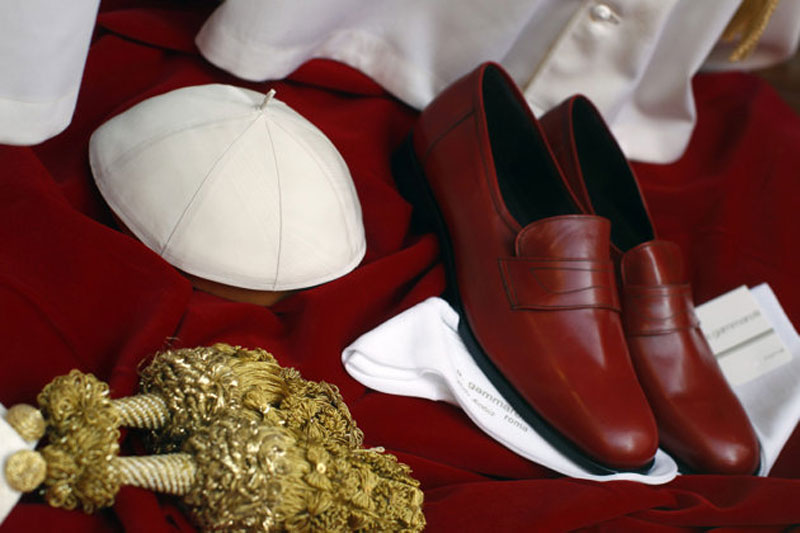 The chosen stylish footwear of Pope Benedict XVI
The chosen stylish footwear of Pope Benedict XVI
Francis I, as his chosen name suggests, is a humbler man with unostentatious tastes. At his first mass as Pope in the Vatican, he wore black shoes, not red ones. Within days of his election, he instructed the cardinals to wear plain black cassocks and not red with white lace surplices – which might ruffle the plumes of the more sartorially flamboyant cardinals!
Cardinals in glorious crimson, symbolizing the blood of martyrs.
Some ecclesiastical appurtenances are worn exclusively by a pope: e.g. the pallium (worn over the chasuble); the white pellegrina (a cassock with a shoulder cape attached to it), girded with the fringed white faschia (with the papal coat of arms embroidered on it), the red papal shoes, and the red or white broad-brimmed capello romano.
It will be interesting to see whether Pope Francis I abandons or at least reduces all the fusspottery of traditional papal attire. Some of these august shops I have been discussing might have to re-stock or close shop. Tempora mutantur!
TERENCE RODRIGUES, besides being an author and critic, is an international art consultant, advising private clients on art sales and acquisitions.
Tel: 07905 474 394 (m) & 0207 828 9255 (w)







